Accounting and Bookkeeping Assessment 1: FNS40217 Homework
VerifiedAdded on 2023/03/20
|11
|2004
|83
Homework Assignment
AI Summary
This document presents a comprehensive solution to an accounting and bookkeeping assignment, addressing various aspects of the field. The assignment covers topics such as the importance of accurate financial data, management of receipts and payments, and regulatory compliance. It explores the roles of bookkeepers and accountants, including their functions, qualifications, and ethical responsibilities. The solution also delves into specific tasks like tax credits, depreciation, and budget preparation, along with the use of accounting software. Furthermore, it examines ethical principles, legal requirements related to employee payments, and the application of the Privacy Act. The assignment includes practical examples, such as invoice analysis and GST reporting, and concludes with a discussion of system goals and evaluation methods.
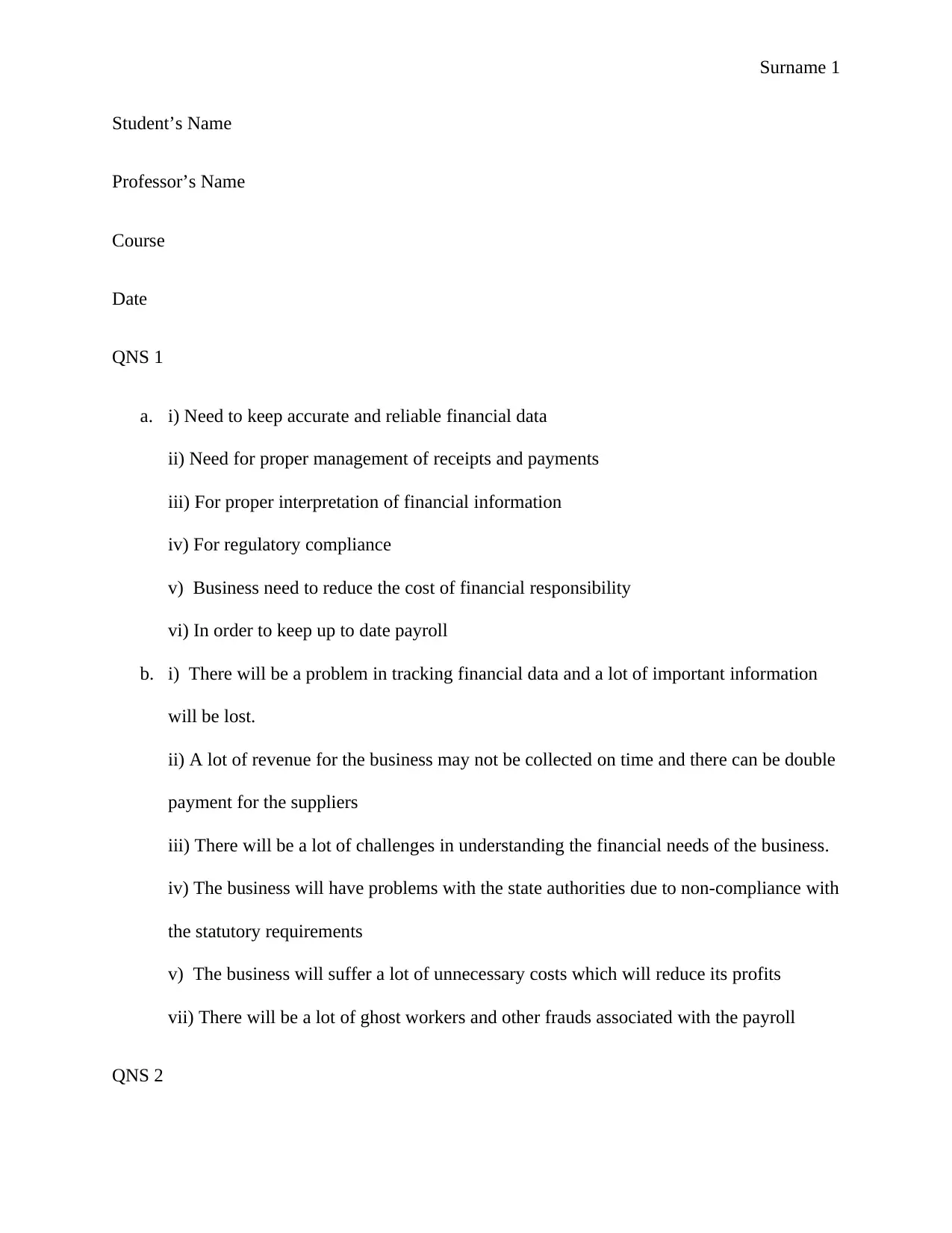
Surname 1
Student’s Name
Professor’s Name
Course
Date
QNS 1
a. i) Need to keep accurate and reliable financial data
ii) Need for proper management of receipts and payments
iii) For proper interpretation of financial information
iv) For regulatory compliance
v) Business need to reduce the cost of financial responsibility
vi) In order to keep up to date payroll
b. i) There will be a problem in tracking financial data and a lot of important information
will be lost.
ii) A lot of revenue for the business may not be collected on time and there can be double
payment for the suppliers
iii) There will be a lot of challenges in understanding the financial needs of the business.
iv) The business will have problems with the state authorities due to non-compliance with
the statutory requirements
v) The business will suffer a lot of unnecessary costs which will reduce its profits
vii) There will be a lot of ghost workers and other frauds associated with the payroll
QNS 2
Student’s Name
Professor’s Name
Course
Date
QNS 1
a. i) Need to keep accurate and reliable financial data
ii) Need for proper management of receipts and payments
iii) For proper interpretation of financial information
iv) For regulatory compliance
v) Business need to reduce the cost of financial responsibility
vi) In order to keep up to date payroll
b. i) There will be a problem in tracking financial data and a lot of important information
will be lost.
ii) A lot of revenue for the business may not be collected on time and there can be double
payment for the suppliers
iii) There will be a lot of challenges in understanding the financial needs of the business.
iv) The business will have problems with the state authorities due to non-compliance with
the statutory requirements
v) The business will suffer a lot of unnecessary costs which will reduce its profits
vii) There will be a lot of ghost workers and other frauds associated with the payroll
QNS 2
Secure Best Marks with AI Grader
Need help grading? Try our AI Grader for instant feedback on your assignments.
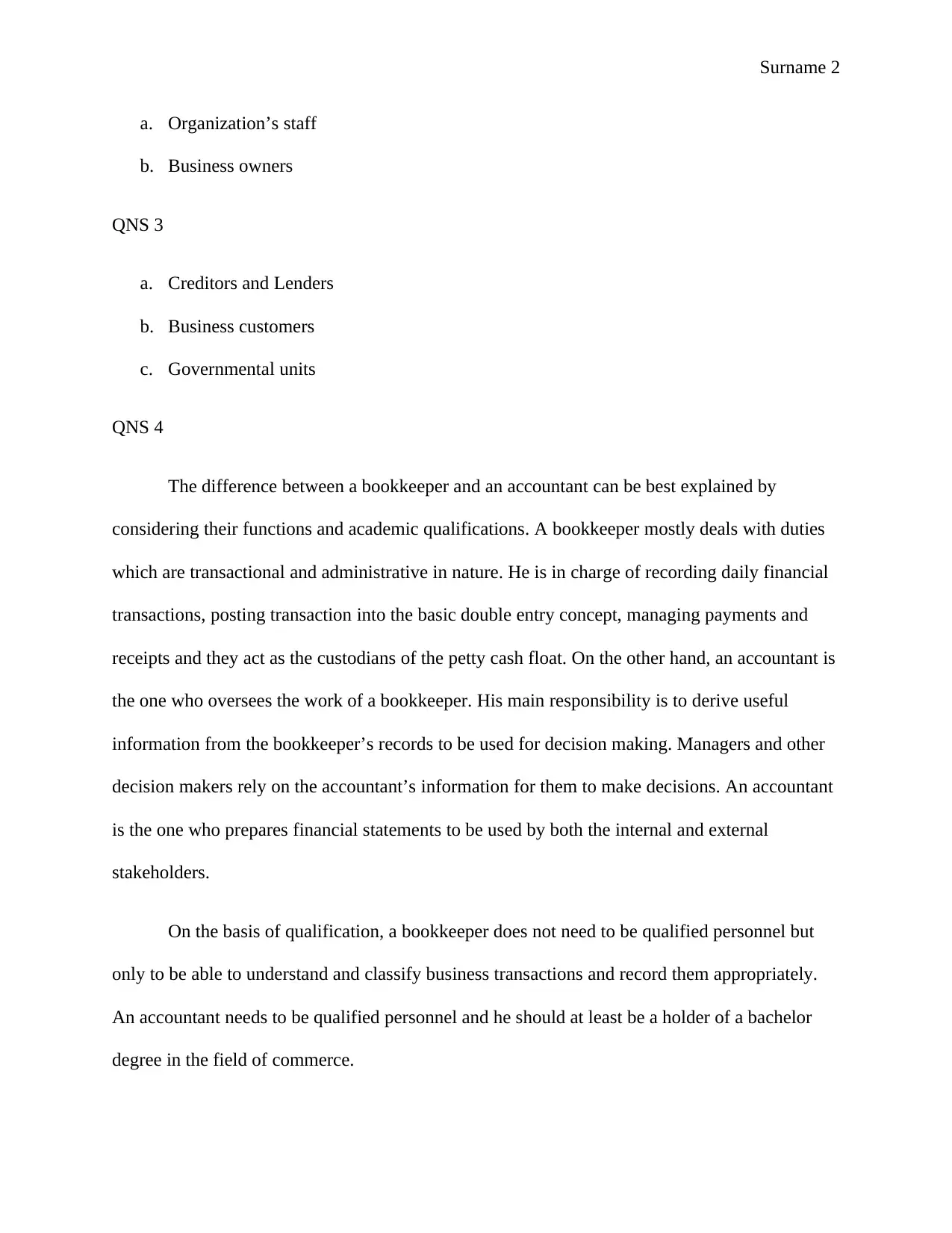
Surname 2
a. Organization’s staff
b. Business owners
QNS 3
a. Creditors and Lenders
b. Business customers
c. Governmental units
QNS 4
The difference between a bookkeeper and an accountant can be best explained by
considering their functions and academic qualifications. A bookkeeper mostly deals with duties
which are transactional and administrative in nature. He is in charge of recording daily financial
transactions, posting transaction into the basic double entry concept, managing payments and
receipts and they act as the custodians of the petty cash float. On the other hand, an accountant is
the one who oversees the work of a bookkeeper. His main responsibility is to derive useful
information from the bookkeeper’s records to be used for decision making. Managers and other
decision makers rely on the accountant’s information for them to make decisions. An accountant
is the one who prepares financial statements to be used by both the internal and external
stakeholders.
On the basis of qualification, a bookkeeper does not need to be qualified personnel but
only to be able to understand and classify business transactions and record them appropriately.
An accountant needs to be qualified personnel and he should at least be a holder of a bachelor
degree in the field of commerce.
a. Organization’s staff
b. Business owners
QNS 3
a. Creditors and Lenders
b. Business customers
c. Governmental units
QNS 4
The difference between a bookkeeper and an accountant can be best explained by
considering their functions and academic qualifications. A bookkeeper mostly deals with duties
which are transactional and administrative in nature. He is in charge of recording daily financial
transactions, posting transaction into the basic double entry concept, managing payments and
receipts and they act as the custodians of the petty cash float. On the other hand, an accountant is
the one who oversees the work of a bookkeeper. His main responsibility is to derive useful
information from the bookkeeper’s records to be used for decision making. Managers and other
decision makers rely on the accountant’s information for them to make decisions. An accountant
is the one who prepares financial statements to be used by both the internal and external
stakeholders.
On the basis of qualification, a bookkeeper does not need to be qualified personnel but
only to be able to understand and classify business transactions and record them appropriately.
An accountant needs to be qualified personnel and he should at least be a holder of a bachelor
degree in the field of commerce.
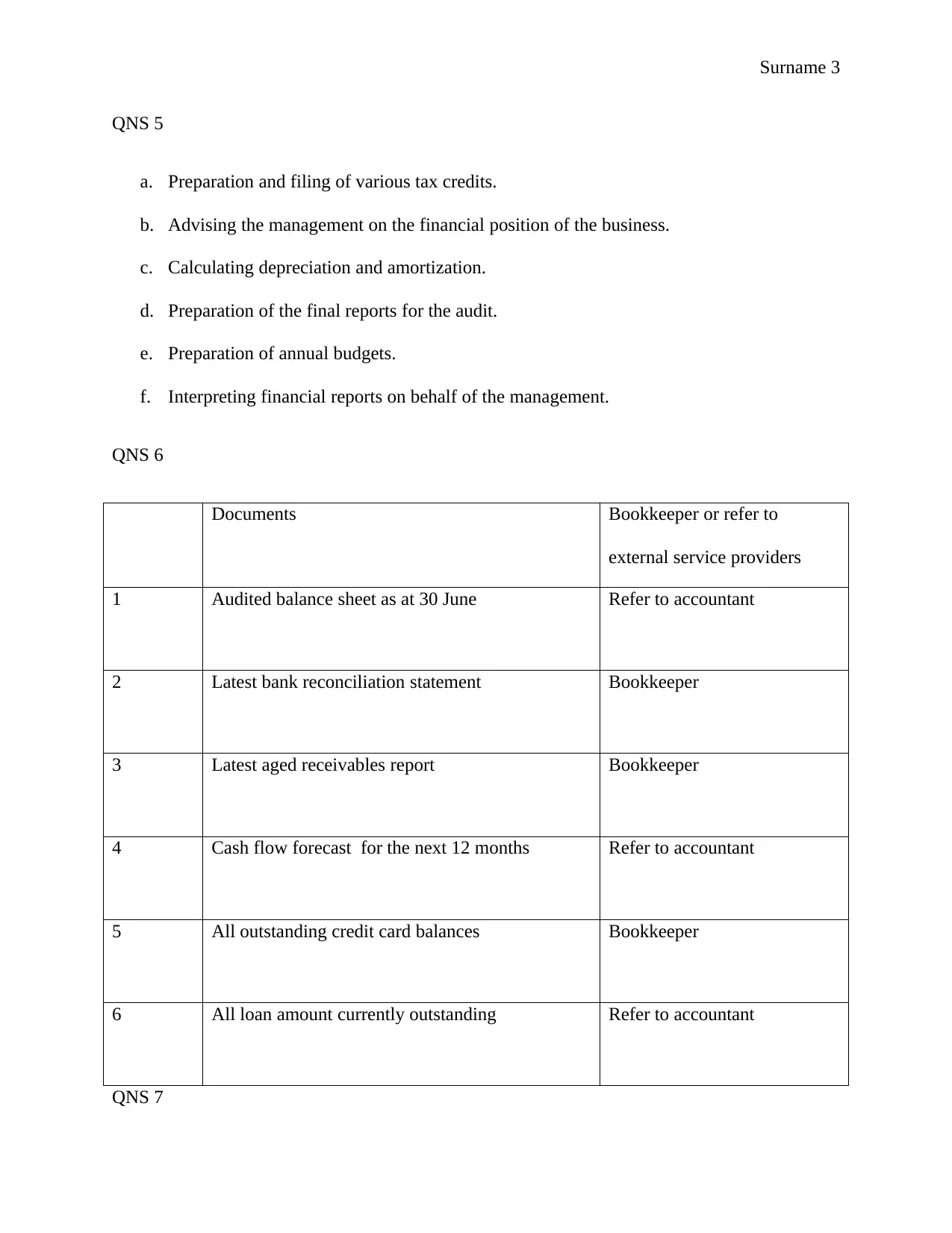
Surname 3
QNS 5
a. Preparation and filing of various tax credits.
b. Advising the management on the financial position of the business.
c. Calculating depreciation and amortization.
d. Preparation of the final reports for the audit.
e. Preparation of annual budgets.
f. Interpreting financial reports on behalf of the management.
QNS 6
Documents Bookkeeper or refer to
external service providers
1 Audited balance sheet as at 30 June Refer to accountant
2 Latest bank reconciliation statement Bookkeeper
3 Latest aged receivables report Bookkeeper
4 Cash flow forecast for the next 12 months Refer to accountant
5 All outstanding credit card balances Bookkeeper
6 All loan amount currently outstanding Refer to accountant
QNS 7
QNS 5
a. Preparation and filing of various tax credits.
b. Advising the management on the financial position of the business.
c. Calculating depreciation and amortization.
d. Preparation of the final reports for the audit.
e. Preparation of annual budgets.
f. Interpreting financial reports on behalf of the management.
QNS 6
Documents Bookkeeper or refer to
external service providers
1 Audited balance sheet as at 30 June Refer to accountant
2 Latest bank reconciliation statement Bookkeeper
3 Latest aged receivables report Bookkeeper
4 Cash flow forecast for the next 12 months Refer to accountant
5 All outstanding credit card balances Bookkeeper
6 All loan amount currently outstanding Refer to accountant
QNS 7
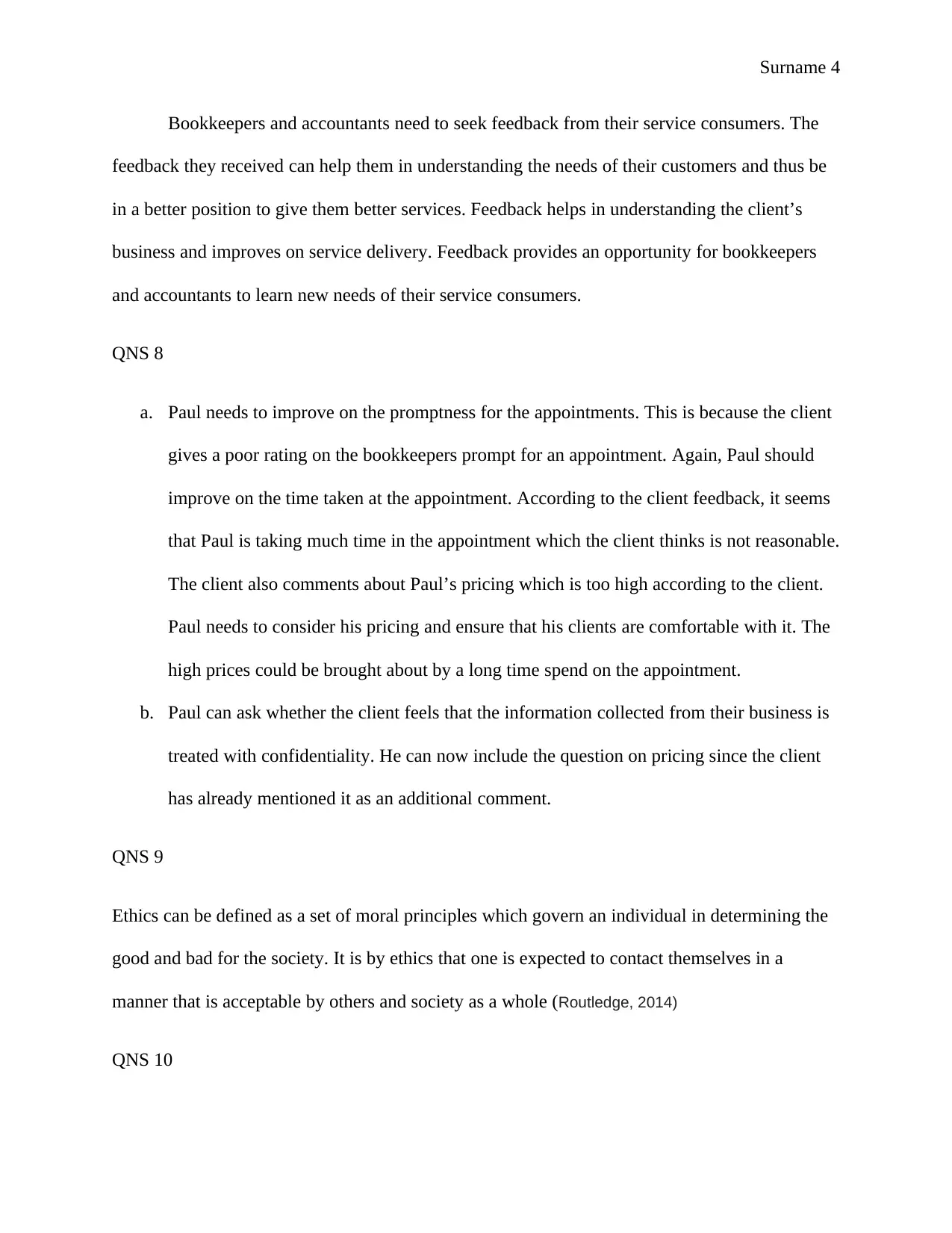
Surname 4
Bookkeepers and accountants need to seek feedback from their service consumers. The
feedback they received can help them in understanding the needs of their customers and thus be
in a better position to give them better services. Feedback helps in understanding the client’s
business and improves on service delivery. Feedback provides an opportunity for bookkeepers
and accountants to learn new needs of their service consumers.
QNS 8
a. Paul needs to improve on the promptness for the appointments. This is because the client
gives a poor rating on the bookkeepers prompt for an appointment. Again, Paul should
improve on the time taken at the appointment. According to the client feedback, it seems
that Paul is taking much time in the appointment which the client thinks is not reasonable.
The client also comments about Paul’s pricing which is too high according to the client.
Paul needs to consider his pricing and ensure that his clients are comfortable with it. The
high prices could be brought about by a long time spend on the appointment.
b. Paul can ask whether the client feels that the information collected from their business is
treated with confidentiality. He can now include the question on pricing since the client
has already mentioned it as an additional comment.
QNS 9
Ethics can be defined as a set of moral principles which govern an individual in determining the
good and bad for the society. It is by ethics that one is expected to contact themselves in a
manner that is acceptable by others and society as a whole (Routledge, 2014)
QNS 10
Bookkeepers and accountants need to seek feedback from their service consumers. The
feedback they received can help them in understanding the needs of their customers and thus be
in a better position to give them better services. Feedback helps in understanding the client’s
business and improves on service delivery. Feedback provides an opportunity for bookkeepers
and accountants to learn new needs of their service consumers.
QNS 8
a. Paul needs to improve on the promptness for the appointments. This is because the client
gives a poor rating on the bookkeepers prompt for an appointment. Again, Paul should
improve on the time taken at the appointment. According to the client feedback, it seems
that Paul is taking much time in the appointment which the client thinks is not reasonable.
The client also comments about Paul’s pricing which is too high according to the client.
Paul needs to consider his pricing and ensure that his clients are comfortable with it. The
high prices could be brought about by a long time spend on the appointment.
b. Paul can ask whether the client feels that the information collected from their business is
treated with confidentiality. He can now include the question on pricing since the client
has already mentioned it as an additional comment.
QNS 9
Ethics can be defined as a set of moral principles which govern an individual in determining the
good and bad for the society. It is by ethics that one is expected to contact themselves in a
manner that is acceptable by others and society as a whole (Routledge, 2014)
QNS 10
Secure Best Marks with AI Grader
Need help grading? Try our AI Grader for instant feedback on your assignments.
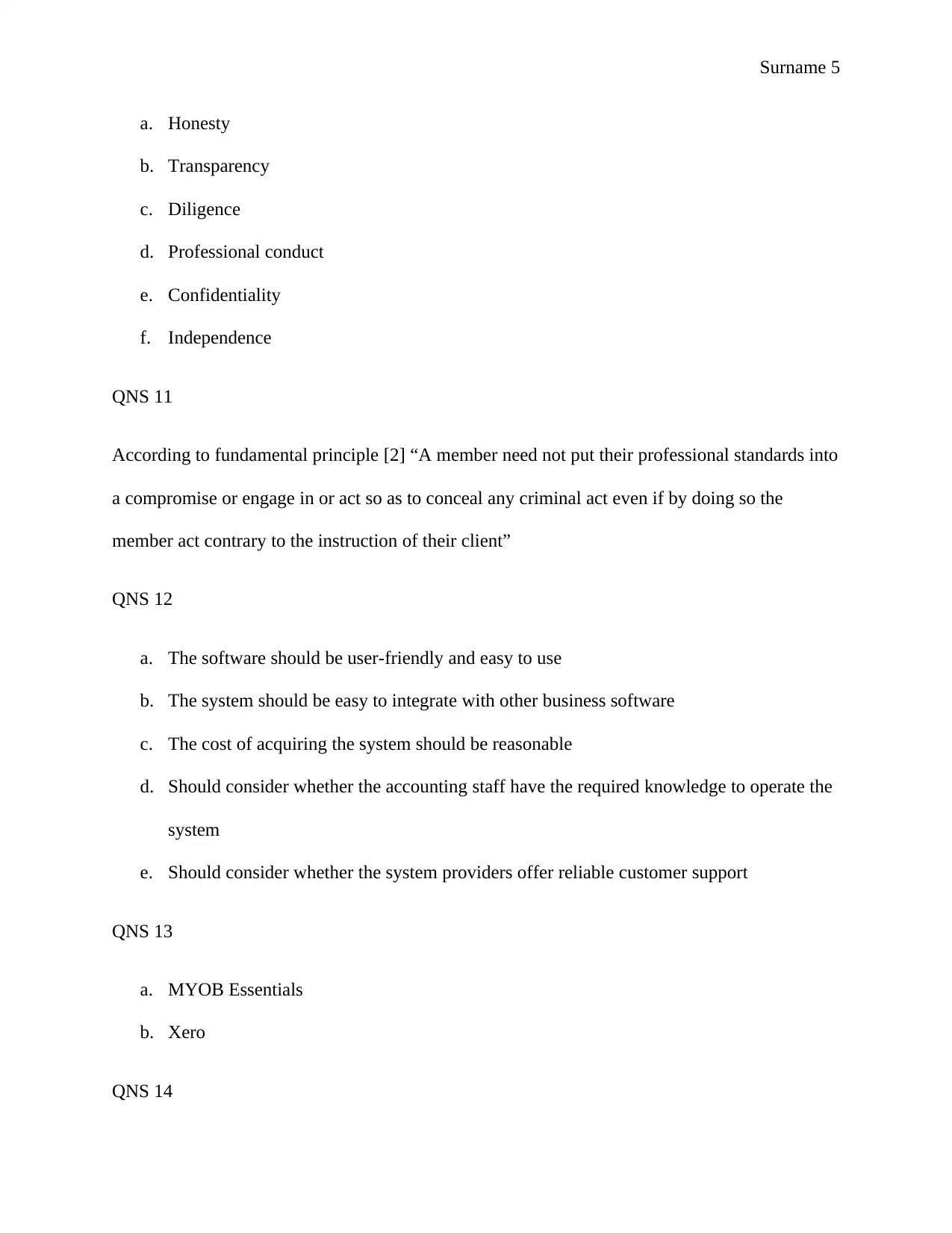
Surname 5
a. Honesty
b. Transparency
c. Diligence
d. Professional conduct
e. Confidentiality
f. Independence
QNS 11
According to fundamental principle [2] “A member need not put their professional standards into
a compromise or engage in or act so as to conceal any criminal act even if by doing so the
member act contrary to the instruction of their client”
QNS 12
a. The software should be user-friendly and easy to use
b. The system should be easy to integrate with other business software
c. The cost of acquiring the system should be reasonable
d. Should consider whether the accounting staff have the required knowledge to operate the
system
e. Should consider whether the system providers offer reliable customer support
QNS 13
a. MYOB Essentials
b. Xero
QNS 14
a. Honesty
b. Transparency
c. Diligence
d. Professional conduct
e. Confidentiality
f. Independence
QNS 11
According to fundamental principle [2] “A member need not put their professional standards into
a compromise or engage in or act so as to conceal any criminal act even if by doing so the
member act contrary to the instruction of their client”
QNS 12
a. The software should be user-friendly and easy to use
b. The system should be easy to integrate with other business software
c. The cost of acquiring the system should be reasonable
d. Should consider whether the accounting staff have the required knowledge to operate the
system
e. Should consider whether the system providers offer reliable customer support
QNS 13
a. MYOB Essentials
b. Xero
QNS 14
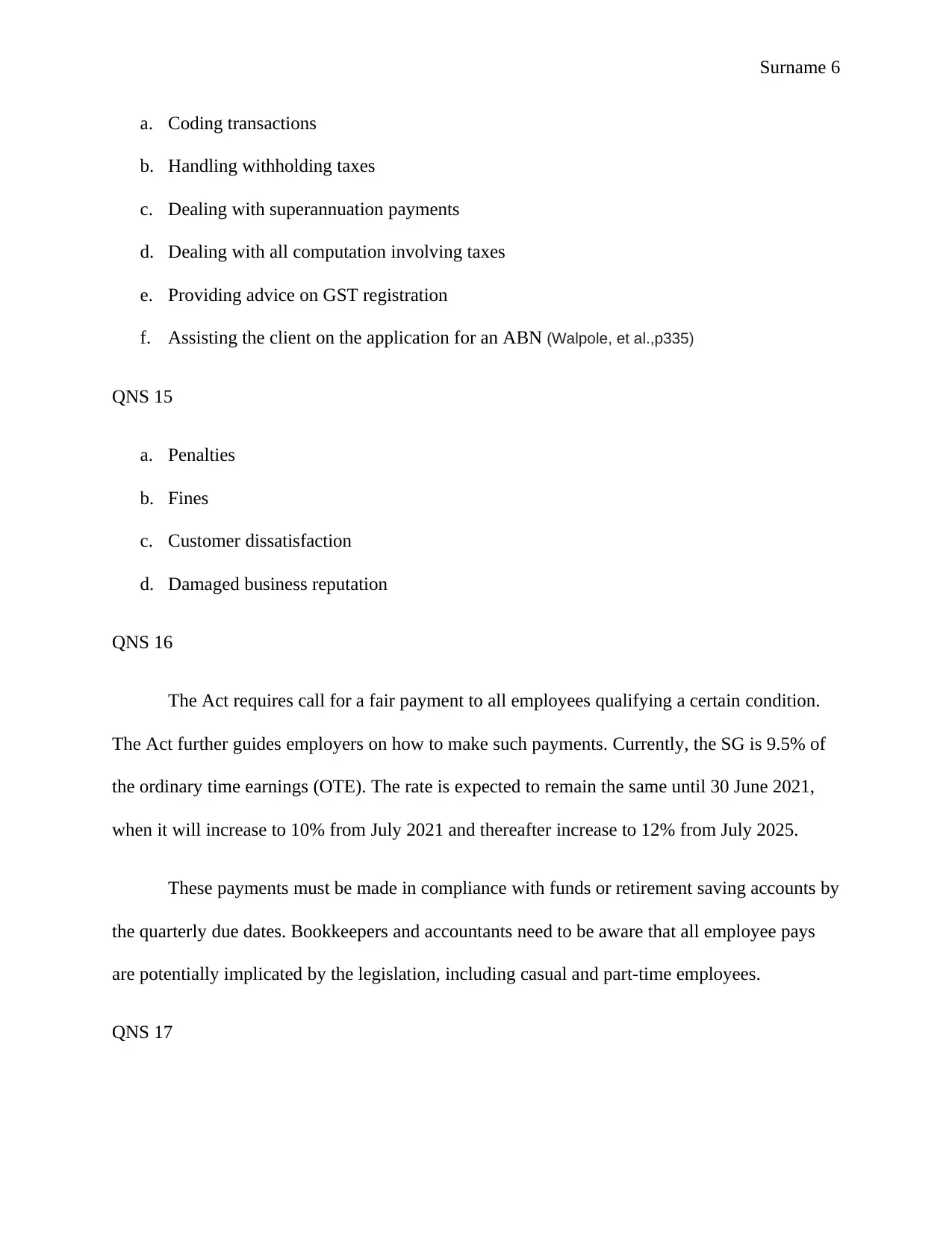
Surname 6
a. Coding transactions
b. Handling withholding taxes
c. Dealing with superannuation payments
d. Dealing with all computation involving taxes
e. Providing advice on GST registration
f. Assisting the client on the application for an ABN (Walpole, et al.,p335)
QNS 15
a. Penalties
b. Fines
c. Customer dissatisfaction
d. Damaged business reputation
QNS 16
The Act requires call for a fair payment to all employees qualifying a certain condition.
The Act further guides employers on how to make such payments. Currently, the SG is 9.5% of
the ordinary time earnings (OTE). The rate is expected to remain the same until 30 June 2021,
when it will increase to 10% from July 2021 and thereafter increase to 12% from July 2025.
These payments must be made in compliance with funds or retirement saving accounts by
the quarterly due dates. Bookkeepers and accountants need to be aware that all employee pays
are potentially implicated by the legislation, including casual and part-time employees.
QNS 17
a. Coding transactions
b. Handling withholding taxes
c. Dealing with superannuation payments
d. Dealing with all computation involving taxes
e. Providing advice on GST registration
f. Assisting the client on the application for an ABN (Walpole, et al.,p335)
QNS 15
a. Penalties
b. Fines
c. Customer dissatisfaction
d. Damaged business reputation
QNS 16
The Act requires call for a fair payment to all employees qualifying a certain condition.
The Act further guides employers on how to make such payments. Currently, the SG is 9.5% of
the ordinary time earnings (OTE). The rate is expected to remain the same until 30 June 2021,
when it will increase to 10% from July 2021 and thereafter increase to 12% from July 2025.
These payments must be made in compliance with funds or retirement saving accounts by
the quarterly due dates. Bookkeepers and accountants need to be aware that all employee pays
are potentially implicated by the legislation, including casual and part-time employees.
QNS 17
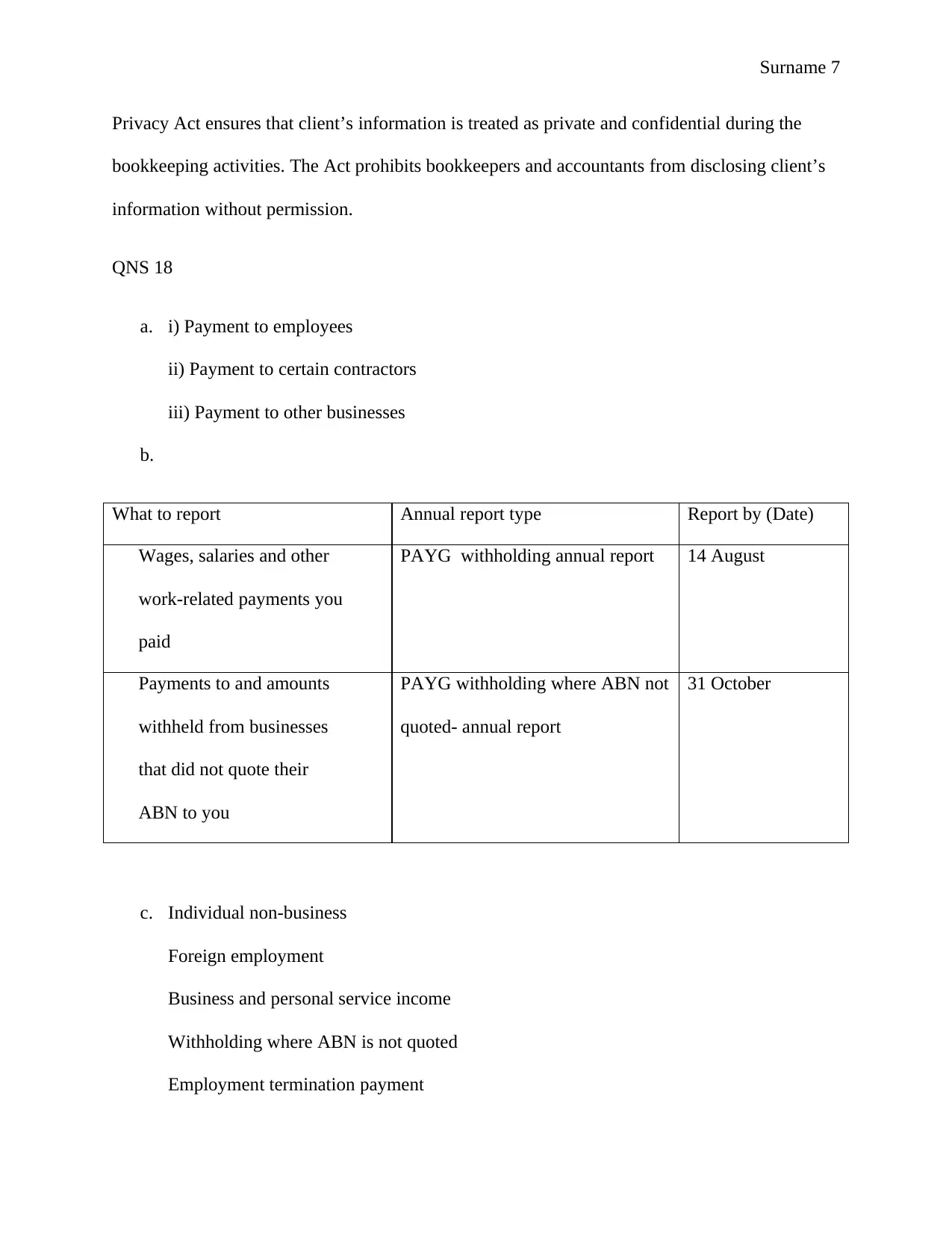
Surname 7
Privacy Act ensures that client’s information is treated as private and confidential during the
bookkeeping activities. The Act prohibits bookkeepers and accountants from disclosing client’s
information without permission.
QNS 18
a. i) Payment to employees
ii) Payment to certain contractors
iii) Payment to other businesses
b.
What to report Annual report type Report by (Date)
Wages, salaries and other
work-related payments you
paid
PAYG withholding annual report 14 August
Payments to and amounts
withheld from businesses
that did not quote their
ABN to you
PAYG withholding where ABN not
quoted- annual report
31 October
c. Individual non-business
Foreign employment
Business and personal service income
Withholding where ABN is not quoted
Employment termination payment
Privacy Act ensures that client’s information is treated as private and confidential during the
bookkeeping activities. The Act prohibits bookkeepers and accountants from disclosing client’s
information without permission.
QNS 18
a. i) Payment to employees
ii) Payment to certain contractors
iii) Payment to other businesses
b.
What to report Annual report type Report by (Date)
Wages, salaries and other
work-related payments you
paid
PAYG withholding annual report 14 August
Payments to and amounts
withheld from businesses
that did not quote their
ABN to you
PAYG withholding where ABN not
quoted- annual report
31 October
c. Individual non-business
Foreign employment
Business and personal service income
Withholding where ABN is not quoted
Employment termination payment
Paraphrase This Document
Need a fresh take? Get an instant paraphrase of this document with our AI Paraphraser
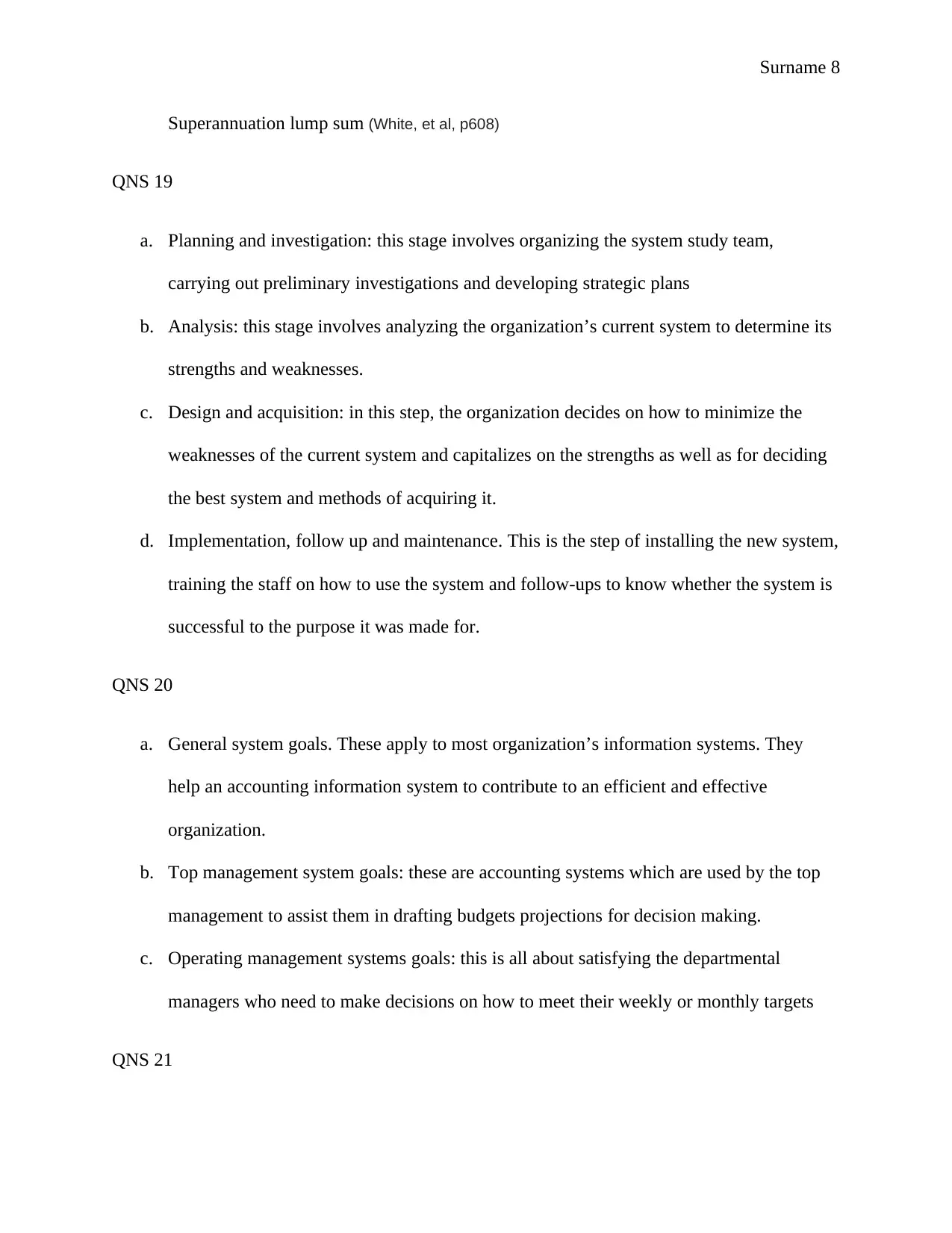
Surname 8
Superannuation lump sum (White, et al, p608)
QNS 19
a. Planning and investigation: this stage involves organizing the system study team,
carrying out preliminary investigations and developing strategic plans
b. Analysis: this stage involves analyzing the organization’s current system to determine its
strengths and weaknesses.
c. Design and acquisition: in this step, the organization decides on how to minimize the
weaknesses of the current system and capitalizes on the strengths as well as for deciding
the best system and methods of acquiring it.
d. Implementation, follow up and maintenance. This is the step of installing the new system,
training the staff on how to use the system and follow-ups to know whether the system is
successful to the purpose it was made for.
QNS 20
a. General system goals. These apply to most organization’s information systems. They
help an accounting information system to contribute to an efficient and effective
organization.
b. Top management system goals: these are accounting systems which are used by the top
management to assist them in drafting budgets projections for decision making.
c. Operating management systems goals: this is all about satisfying the departmental
managers who need to make decisions on how to meet their weekly or monthly targets
QNS 21
Superannuation lump sum (White, et al, p608)
QNS 19
a. Planning and investigation: this stage involves organizing the system study team,
carrying out preliminary investigations and developing strategic plans
b. Analysis: this stage involves analyzing the organization’s current system to determine its
strengths and weaknesses.
c. Design and acquisition: in this step, the organization decides on how to minimize the
weaknesses of the current system and capitalizes on the strengths as well as for deciding
the best system and methods of acquiring it.
d. Implementation, follow up and maintenance. This is the step of installing the new system,
training the staff on how to use the system and follow-ups to know whether the system is
successful to the purpose it was made for.
QNS 20
a. General system goals. These apply to most organization’s information systems. They
help an accounting information system to contribute to an efficient and effective
organization.
b. Top management system goals: these are accounting systems which are used by the top
management to assist them in drafting budgets projections for decision making.
c. Operating management systems goals: this is all about satisfying the departmental
managers who need to make decisions on how to meet their weekly or monthly targets
QNS 21
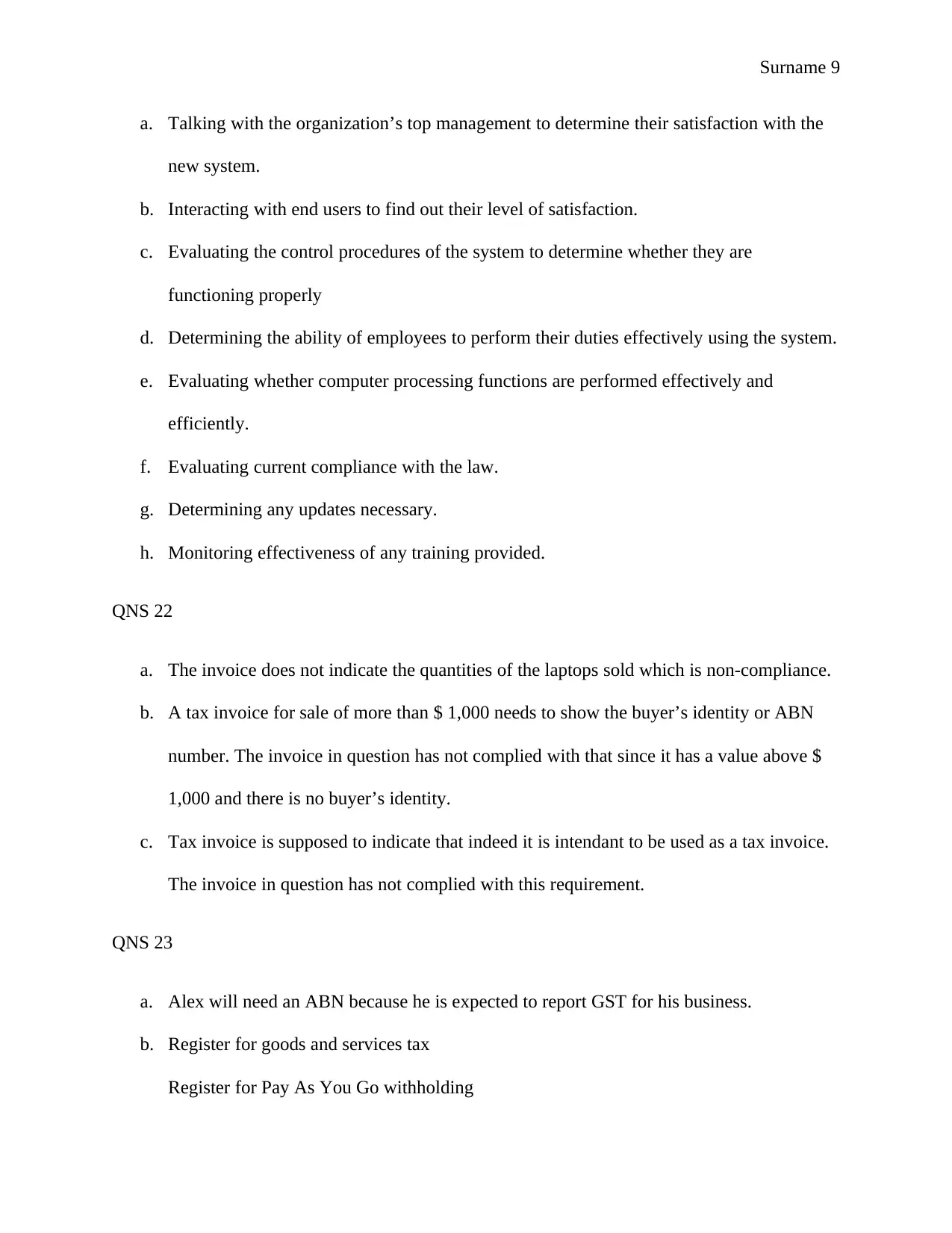
Surname 9
a. Talking with the organization’s top management to determine their satisfaction with the
new system.
b. Interacting with end users to find out their level of satisfaction.
c. Evaluating the control procedures of the system to determine whether they are
functioning properly
d. Determining the ability of employees to perform their duties effectively using the system.
e. Evaluating whether computer processing functions are performed effectively and
efficiently.
f. Evaluating current compliance with the law.
g. Determining any updates necessary.
h. Monitoring effectiveness of any training provided.
QNS 22
a. The invoice does not indicate the quantities of the laptops sold which is non-compliance.
b. A tax invoice for sale of more than $ 1,000 needs to show the buyer’s identity or ABN
number. The invoice in question has not complied with that since it has a value above $
1,000 and there is no buyer’s identity.
c. Tax invoice is supposed to indicate that indeed it is intendant to be used as a tax invoice.
The invoice in question has not complied with this requirement.
QNS 23
a. Alex will need an ABN because he is expected to report GST for his business.
b. Register for goods and services tax
Register for Pay As You Go withholding
a. Talking with the organization’s top management to determine their satisfaction with the
new system.
b. Interacting with end users to find out their level of satisfaction.
c. Evaluating the control procedures of the system to determine whether they are
functioning properly
d. Determining the ability of employees to perform their duties effectively using the system.
e. Evaluating whether computer processing functions are performed effectively and
efficiently.
f. Evaluating current compliance with the law.
g. Determining any updates necessary.
h. Monitoring effectiveness of any training provided.
QNS 22
a. The invoice does not indicate the quantities of the laptops sold which is non-compliance.
b. A tax invoice for sale of more than $ 1,000 needs to show the buyer’s identity or ABN
number. The invoice in question has not complied with that since it has a value above $
1,000 and there is no buyer’s identity.
c. Tax invoice is supposed to indicate that indeed it is intendant to be used as a tax invoice.
The invoice in question has not complied with this requirement.
QNS 23
a. Alex will need an ABN because he is expected to report GST for his business.
b. Register for goods and services tax
Register for Pay As You Go withholding
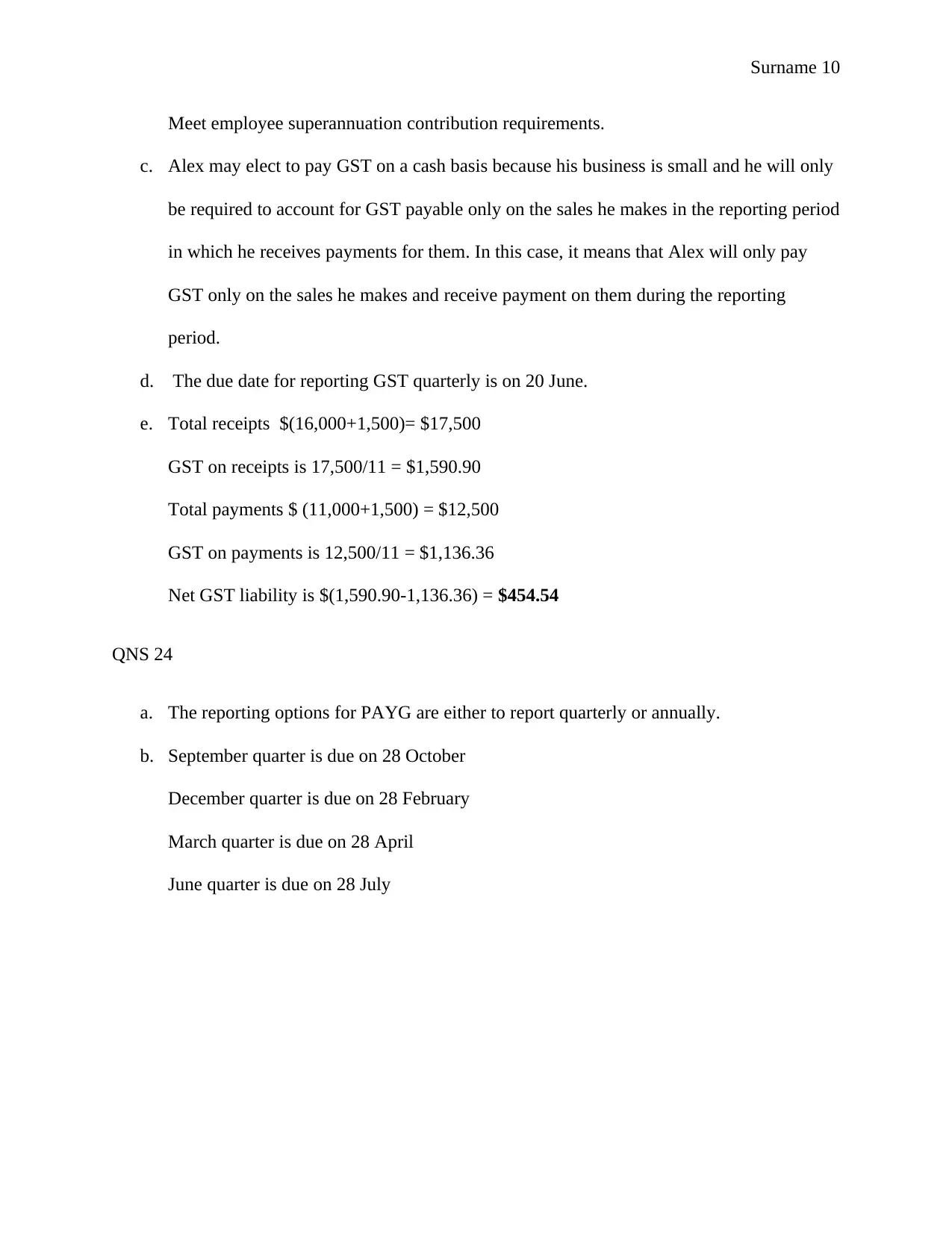
Surname 10
Meet employee superannuation contribution requirements.
c. Alex may elect to pay GST on a cash basis because his business is small and he will only
be required to account for GST payable only on the sales he makes in the reporting period
in which he receives payments for them. In this case, it means that Alex will only pay
GST only on the sales he makes and receive payment on them during the reporting
period.
d. The due date for reporting GST quarterly is on 20 June.
e. Total receipts $(16,000+1,500)= $17,500
GST on receipts is 17,500/11 = $1,590.90
Total payments $ (11,000+1,500) = $12,500
GST on payments is 12,500/11 = $1,136.36
Net GST liability is $(1,590.90-1,136.36) = $454.54
QNS 24
a. The reporting options for PAYG are either to report quarterly or annually.
b. September quarter is due on 28 October
December quarter is due on 28 February
March quarter is due on 28 April
June quarter is due on 28 July
Meet employee superannuation contribution requirements.
c. Alex may elect to pay GST on a cash basis because his business is small and he will only
be required to account for GST payable only on the sales he makes in the reporting period
in which he receives payments for them. In this case, it means that Alex will only pay
GST only on the sales he makes and receive payment on them during the reporting
period.
d. The due date for reporting GST quarterly is on 20 June.
e. Total receipts $(16,000+1,500)= $17,500
GST on receipts is 17,500/11 = $1,590.90
Total payments $ (11,000+1,500) = $12,500
GST on payments is 12,500/11 = $1,136.36
Net GST liability is $(1,590.90-1,136.36) = $454.54
QNS 24
a. The reporting options for PAYG are either to report quarterly or annually.
b. September quarter is due on 28 October
December quarter is due on 28 February
March quarter is due on 28 April
June quarter is due on 28 July
Secure Best Marks with AI Grader
Need help grading? Try our AI Grader for instant feedback on your assignments.
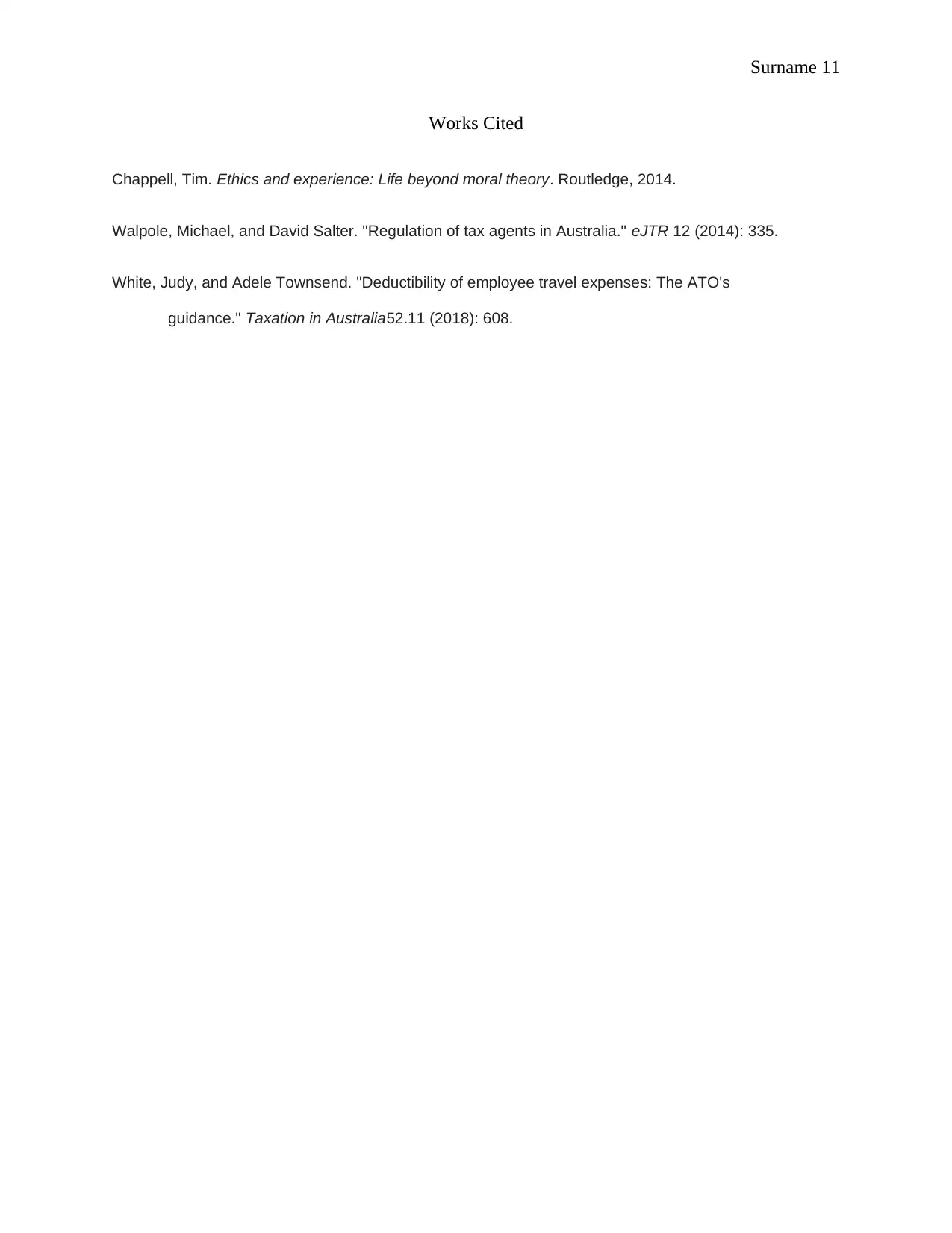
Surname 11
Works Cited
Chappell, Tim. Ethics and experience: Life beyond moral theory. Routledge, 2014.
Walpole, Michael, and David Salter. "Regulation of tax agents in Australia." eJTR 12 (2014): 335.
White, Judy, and Adele Townsend. "Deductibility of employee travel expenses: The ATO's
guidance." Taxation in Australia52.11 (2018): 608.
Works Cited
Chappell, Tim. Ethics and experience: Life beyond moral theory. Routledge, 2014.
Walpole, Michael, and David Salter. "Regulation of tax agents in Australia." eJTR 12 (2014): 335.
White, Judy, and Adele Townsend. "Deductibility of employee travel expenses: The ATO's
guidance." Taxation in Australia52.11 (2018): 608.
1 out of 11
Related Documents
Your All-in-One AI-Powered Toolkit for Academic Success.
+13062052269
info@desklib.com
Available 24*7 on WhatsApp / Email
![[object Object]](/_next/static/media/star-bottom.7253800d.svg)
Unlock your academic potential
© 2024 | Zucol Services PVT LTD | All rights reserved.




